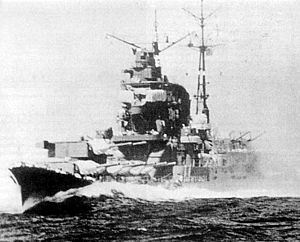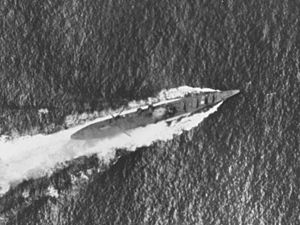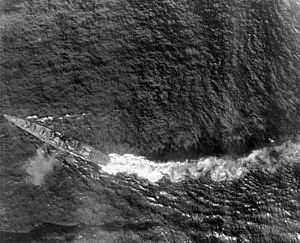Japanese cruiser Chikuma (1938) facts for kids

Japanese heavy cruiser Chikuma
|
|
Quick facts for kids History |
|
|---|---|
| Name | Chikuma |
| Namesake | Chikuma River |
| Ordered | 1932 Fiscal Year |
| Builder | Mitsubishi |
| Laid down | 1 October 1935 |
| Launched | 19 March 1938 |
| Commissioned | 20 May 1939 |
| Stricken | 20 April 1945 |
| Fate | Sank 25 October 1944 after Battle off Samar 11°25′N 126°36′E / 11.417°N 126.600°E |
| General characteristics | |
| Class and type | Tone-class cruiser |
| Displacement | 11,213 tons (standard); 15,443 (final) |
| Length | 189.1 m (620 ft 5 in) |
| Beam | 19.4 m (63 ft 8 in) |
| Draught | 6.2 m (20 ft 4 in) |
| Propulsion |
|
| Speed | 35 knots (65 km/h) |
| Range | 8,000 nmi (15,000 km) at 18 knots (33 km/h) |
| Complement | 874 |
| Armament |
|
| Armor |
|
| Aircraft carried | 6 x floatplanes |
Chikuma (筑摩) was a heavy cruiser in the Imperial Japanese Navy. She was the second and last ship of her type, called the Tone class class. The ship got its name from the Chikuma River in Nagano Prefecture, Japan. Chikuma started serving in 1939 and fought in many battles during World War II in the Pacific Ocean. She was sunk on 25 October 1944 after a big fight called the Battle off Samar.
Contents
Ship Design and Purpose
Chikuma was built for long-distance scouting missions. She could carry many seaplanes. These planes helped her find enemy ships. She often worked with aircraft carriers or with her sister ship, Tone.
The Tone-class cruisers were first planned as part of the Mogami class class. But problems with the Mogami-class design were found in 1935. Japan was no longer limited by the London Naval Treaty, so a new design was made. Chikuma looked similar to the Mogami class from the outside. However, her design was very different. All four main gun turrets were placed at the front of the ship. This left the entire back of the ship free for a large seaplane hangar.
Japanese carriers focused on attack planes. So, cruisers like Chikuma carried long-range scout planes. These planes were important for finding enemy fleets for the Japanese carrier Air Fleets.
Chikuma's Service in World War II
Early Missions
Chikuma was finished on 20 May 1939 at the Mitsubishi shipyards in Nagasaki. She joined the CruDiv8 (Cruiser Division 8) in November 1939. She took part in training exercises in Japan. She also operated off southern China between March 1940 and March 1941.
Pacific War Begins
In late 1941, Chikuma and her sister ship Tone were part of CruDiv 8. They played a key role in the attack on Pearl Harbor. On 7 December 1941, both ships launched Aichi E13A1 "Jake" floatplanes. These planes checked the weather over Oahu. Later, they launched more planes to patrol south of the main Japanese force. Chikuma's plane reported nine American battleships anchored. During the attack, several battleships were sunk or damaged.
On 16 December, CruDiv 8 helped with the second invasion of Wake Island. Chikuma's scout plane was damaged by anti-aircraft fire and had to land in the water. Its crew was saved. After Wake Island fell, CruDiv 8 went back to Kure.
In January 1942, Chikuma was based at Truk. She helped Japanese troops land at Rabaul, New Britain, and attack Lae and Salamaua, New Guinea. On 24 January, Chikuma's floatplanes attacked the Admiralty Islands.
After an American attack on Kwajalein on 1 February, Chikuma tried to chase the American ships but did not find them. Chikuma and Tone then took part in the Raid on Port Darwin, Australia, on 19 February. They sank 11 ships. From 25 February 1942, Chikuma helped the Japanese invasion of Java.
Battle of the Java Sea
On 1 March 1942, Chikuma's floatplane found a Dutch freighter trying to escape. Chikuma, Tone, and two destroyers sank the ship. Later that day, CruDiv 8 found the old destroyer USS Edsall. Chikuma fired her 8-inch guns from far away, but missed. Battleships Hiei and Kirishima also fired. Edsall avoided many shells and even fired back at Chikuma. Finally, hits from Hiei, Tone, and dive bombers stopped Edsall. Chikuma then finished her off.
On 4 March, Chikuma sank another Dutch merchant ship. On 5 March, planes from Tone and Chikuma attacked Tjilatjap. After the Dutch East Indies surrendered, Chikuma was sent to the Indian Ocean.
Indian Ocean Raids
On 5 April 1942, Chikuma was part of a large Japanese force. They launched 315 aircraft against British-held Colombo, Ceylon. They destroyed ships and planes and killed over 500 people in the harbor. They also sank two British cruisers at sea. On 9 April, the force attacked the British naval base at Trincomalee, Ceylon. They found the harbor empty but damaged the base. They also sank the carrier HMS Hermes and other ships at sea.
Chikuma returned to Japan in mid-April 1942. She was then sent to chase Admiral Halsey's American force after the Doolittle Raid, but did not find them.
Battle of Midway
At the important Battle of Midway, Chikuma was with Vice Admiral Chūichi Nagumo's Carrier Striking Force. On 4 June, Tone and Chikuma each launched two "Jake" floatplanes. These planes searched for American carriers. Tones plane found American ships but did not realize they were carriers, which was a big mistake. Chikumas floatplane found the aircraft carrier USS Yorktown. It followed Yorktown for three hours, guiding Japanese bombers to attack her. Two other planes from Chikuma watched the damaged Yorktown through the night. One plane and its crew were lost. Chikuma then directed the submarine I-168 to attack Yorktown the next morning.
Chikuma and Tone were then sent to help with the Japanese invasion of the Aleutian Islands. But no American counter-attack happened. Chikuma returned to Ominato port on 24 June.
On 16 August, Chikuma was ordered south again with several aircraft carriers and battleships. This was because the US had invaded Guadalcanal.
Battle of the Eastern Solomons
On 24 August 1942, more Japanese cruisers joined the fleet for Guadalcanal. The next morning, an American seaplane spotted a Japanese carrier. American planes attacked it but missed. Seven floatplanes from Tone and Chikuma were launched to find the American fleet. One of Chikuma's planes spotted the Americans but was shot down before it could report. However, another plane succeeded. The Japanese then attacked the American carrier Enterprise, hitting it with three bombs. Meanwhile, the Americans found the Japanese fleet, and the carrier Ryūjō was sunk. Chikuma was not damaged in this battle. She returned safely to Truk.
Through October, Chikuma and Tone patrolled north of the Solomon Islands. They waited for news about the Japanese recapture of Henderson Field.
Battle of Santa Cruz
On 26 October 1942, northeast of Guadalcanal, Japanese planes found the American fleet. The Japanese attacked, sinking the carrier Hornet and damaging other ships. However, Chikuma was attacked by an American SBD Dauntless dive-bomber. Her crew quickly threw her torpedoes overboard just before a 500 lb (230 kg) bomb hit her torpedo room. She was also hit by two other bombs, destroying a floatplane on her aircraft catapult. Chikuma had 190 crew members killed and 154 wounded.
Chikuma returned to Truk for emergency repairs. She was then sent back to Kure for more repairs. During this time, she received more anti-aircraft guns and a radar system. Repairs were finished by 27 February 1943.
On 17 May, Chikuma and Tone escorted the battleship Musashi back to Tokyo. This was for the funeral of Admiral Isoroku Yamamoto. Chikuma was back in Truk by 15 July. She avoided many submarine attacks on her journey.
From July to November, Chikuma transported troops to Rabaul. She also patrolled the Marshall Islands, looking for the American fleet. While refueling at Rabaul on 5 November 1943, Chikuma and her group were attacked by 97 planes from American carriers. Several cruisers were damaged. Chikuma was attacked by one SBD but only suffered minor damage from near-misses.
Back in Kure on 12 December, Chikuma received even more 25-mm anti-aircraft guns, bringing her total to 20. CruDiv 8 was broken up on 1 January 1944. Tone and Chikuma were moved to CruDiv 7. After more repairs, Chikuma returned to Singapore on 13 February. She then went to Batavia on 15 March after a month of raiding enemy ships in the Indian Ocean. On 20 March 1944, Chikuma became the flagship of CruDiv 7.
Battle of the Philippine Sea
On 13 June 1944, Admiral Soemu Toyoda started "Operation A-GO" to defend the Mariana Islands. Chikuma was part of Vice Admiral Jisaburo Ozawa's Mobile Fleet. They sailed towards Saipan. On 20 June, American planes attacked Japanese battleships and carriers. Most of the Japanese air cover was destroyed in what was called the "Great Marianas Turkey Shoot". Chikuma then retreated with the Mobile Fleet to Okinawa.
After carrying army troops to Okinawa, Chikuma was sent back to Singapore in July. She served as a flagship while another cruiser was being repaired.
Battle of Leyte Gulf
On 23 October 1944, Chikuma sailed from Brunei towards the Philippines with Vice Admiral Takeo Kurita's force. In the Battle of the Palawan Passage, two Japanese cruisers were sunk by submarines, and one was damaged. In the Battle of the Sibuyan Sea the next day, the battleship Musashi was sunk. Another cruiser was badly damaged and had to be towed.
On 25 October, during the Battle off Samar, Chikuma fought against U.S. escort aircraft carriers. She helped sink USS Gambier Bay. However, she came under fire from the American destroyer USS Heermann and faced heavy air attacks. Chikuma badly damaged Heermann. But then, four American torpedo-bombers attacked Chikuma. One torpedo hit her stern, cutting off part of it and damaging her rudder and propeller. Chikuma's speed dropped, and she could no longer steer.
Later, five more torpedo-bombers attacked Chikuma. She was hit by two torpedoes in the middle of the ship, and her engine rooms flooded. At 2:00 PM, three more torpedo-bombers dropped torpedoes that hit Chikuma. It is believed that the Japanese destroyer Nowaki rescued survivors from Chikuma. Nowaki then sank Chikuma at 11°25′N 126°36′E / 11.417°N 126.600°E on 25 October 1944. However, some studies suggest Chikuma sank from the air attacks, and Nowaki only arrived to pick up survivors from the water.
On 26 October 1944, Nowaki was sunk by American cruisers and destroyers. She sank with about 1,400 men, including almost all of Chikuma's surviving crew. Only one crew member from Chikuma survived. He was not picked up by Nowaki and drifted ashore by himself.
Chikuma was officially removed from the navy list on 20 April 1945.
See also
 In Spanish: Chikuma (1938) para niños
In Spanish: Chikuma (1938) para niños





